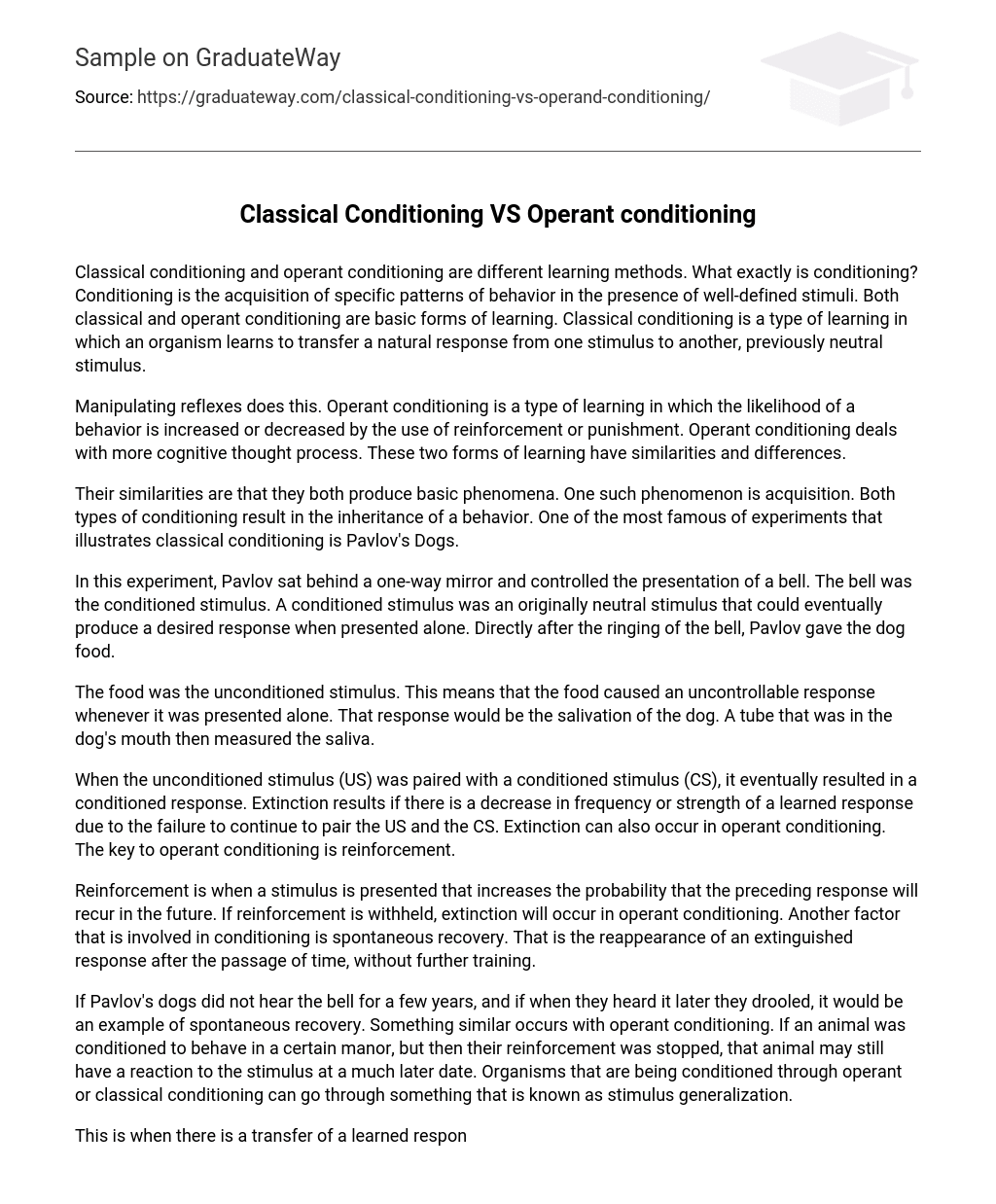Classical conditioning and operant conditioning are different learning methods. What exactly is conditioning? Conditioning is the acquisition of specific patterns of behavior in the presence of well-defined stimuli. Both classical and operant conditioning are basic forms of learning. Classical conditioning is a type of learning in which an organism learns to transfer a natural response from one stimulus to another, previously neutral stimulus.
Manipulating reflexes does this. Operant conditioning is a type of learning in which the likelihood of a behavior is increased or decreased by the use of reinforcement or punishment. Operant conditioning deals with more cognitive thought process. These two forms of learning have similarities and differences.
Their similarities are that they both produce basic phenomena. One such phenomenon is acquisition. Both types of conditioning result in the inheritance of a behavior. One of the most famous of experiments that illustrates classical conditioning is Pavlov’s Dogs.
In this experiment, Pavlov sat behind a one-way mirror and controlled the presentation of a bell. The bell was the conditioned stimulus. A conditioned stimulus was an originally neutral stimulus that could eventually produce a desired response when presented alone. Directly after the ringing of the bell, Pavlov gave the dog food.
The food was the unconditioned stimulus. This means that the food caused an uncontrollable response whenever it was presented alone. That response would be the salivation of the dog. A tube that was in the dog’s mouth then measured the saliva.
When the unconditioned stimulus (US) was paired with a conditioned stimulus (CS), it eventually resulted in a conditioned response. Extinction results if there is a decrease in frequency or strength of a learned response due to the failure to continue to pair the US and the CS. Extinction can also occur in operant conditioning. The key to operant conditioning is reinforcement.
Reinforcement is when a stimulus is presented that increases the probability that the preceding response will recur in the future. If reinforcement is withheld, extinction will occur in operant conditioning. Another factor that is involved in conditioning is spontaneous recovery. That is the reappearance of an extinguished response after the passage of time, without further training.
If Pavlov’s dogs did not hear the bell for a few years, and if when they heard it later they drooled, it would be an example of spontaneous recovery. Something similar occurs with operant conditioning. If an animal was conditioned to behave in a certain manor, but then their reinforcement was stopped, that animal may still have a reaction to the stimulus at a much later date. Organisms that are being conditioned through operant or classical conditioning can go through something that is known as stimulus generalization.
This is when there is a transfer of a learned response to different but similar stimuli. An example would be if one of Pavlov’s dogs salivated to the sound of a bell that was different from the one that they were originally conditioned with. Stimulus discrimination is another phenomena that occurs with classical and operant conditioning. Discrimination is when an organism learns to respond to only one stimulus and inhibit the response to all other stimuli.
It is the reverse of generalization. If an organism hears many different sounds, but is only given reinforcement for responding to only one of the sounds, it learns to discriminate between the sounds. Some of the differences between operant and classical conditioning lie in the extent to which reinforcement depends on the behavior of the learner. In classical conditioning, the learner is automatically reinforced.
That is how it learns to respond to a once neutral stimulus. In operant conditioning, the learner must provide a correct response in order to received the reinforcement. Another difference between the two forms of conditioning is the type of behavior to which each method applies. Classical conditioning applies to a behavior that is always wanted.
It was Pavlov’s purpose to have the dogs salivate on command. In operant conditioning, a behavior can be learned or extinguished. If you wanted to train a dog not to do something, you would use a form of punishment. Classical and operant conditioning are similar, but they do differ in a few ways.
Both are fairly reliable ways to teach an organism to act in a specific manor.





